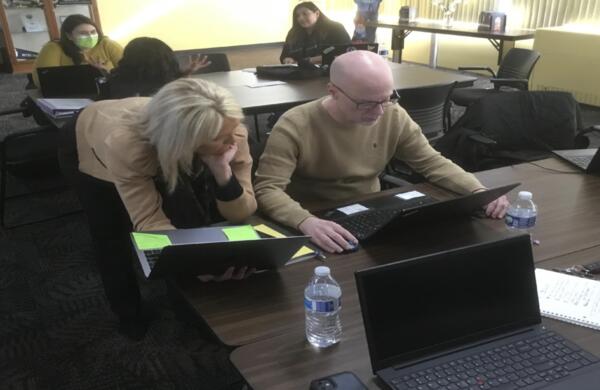
New Tech Network School Development Coach Carla Smith shares the New Tech method with Lake Ridge teachers.
Lake Ridge New Tech teachers met in the district’s administrative conference room for professional development training that focused on ways to incorporate an innovative teaching strategy into current curriculum.
They focused on the New Tech method, which involves problem-based learning. It’s a theory that teaches students how to solve and explain complex issues.
New Tech Co-CEO Lydia Dobyns says the New Tech philosophy was born in Napa, California, in 1996 out of concern from community business leaders who felt high school graduates were lacking the necessary skills to advance their careers.
“It was founded because there was a shared desire to reimagine the high school experience so that students developed the skills and experiences necessary to pursue and achieve success after graduation,” Dobyns said. “It was a collaboration among local entrepreneurs, teachers, and district leadership.”
Dobyns says that today, that concern is still relevant in the New Tech Network, with “over 200 high schools committed to college and career ready outcomes, supportive and inclusive culture, meaningful and equitable instruction, and purposeful assessment.”
Lake Ridge New Tech Superintendent Dr. Sharon Johnson-Shirley saw the vision behind the New Tech theory nearly 13 years ago and adopted the method as a part of the entire school district’s classroom practice.
“New Tech sold me when it targeted students that had lost interest in school. They found a way to reach those young people,” Dr. Johnson-Shirley said. “It piqued my interest, so I visited Napa Valley. I visited several other schools. I liked the philosophy that teachers were the facilitators of the learning and students were responsible for the learning. That is when I decided it would be good for Calumet.”
Carla Smith is a school development coach with the New Tech Network. She travels throughout Michigan, Indiana, Kentucky, and Ohio presenting the New Tech strategies to network member school districts.
A former teacher, principal, and literacy coach from Lansing, Michigan, the 30-year teaching veteran has seen education grow from the traditional teacher-as-lecturer in the days before the No Child Left Behind Act to the teacher-as-facilitator in the 21st century. She is also an education doctoral candidate at Michigan State University.
Smith believes the New Tech method of discussion, problem-solving, team building, and student-centered accountability is one of the best ways to approach teaching today’s social media-influenced students.
“Now, at an early age, students are exposed to different pathways for lifelong success. It’s not that traditional four-year college—that’s not the way students today are wired. You have to have a different approach,” said Smith. “Kids have to learn 21st-century skills because that is what they are going to use when they leave these doors, and that’s what the New Tech Network offers them.”
While the New Tech model has remained consistent at Lake Ridge, the inevitabilities of change have played a role in the method of teaching over the years. As teachers retire or change jobs, it becomes critical for new teachers—many of whom are not familiar with the New Tech Network—to learn the model.
According to Assistant Superintendent Cindy Mose-Trevino, New Tech-sponsored workshops play a critical role in maintaining the continuity of the program.
“Training is important because we have a lot of new staff, and many are new to teaching,” said Trevino. “For example, 73 percent of the teachers at Longfellow are brand-new teachers. We have many teachers who need to understand how to develop their curriculum and create an engaging culture and climate in their classroom, as students are still recovering from the learning loss caused by the pandemic. We have to have New Tech professional development to give teachers the tools in their toolbox so that students can have the best possible learning environment.”
Third-year Longfellow first-grade teacher Sarah Stafford said the New Tech workshop was beneficial. Stafford said she “thought this was a useful time for us to wrap our heads around how to implement the NTN process.”
First-year Longfellow third-grade teacher Asada Muhammad said she is “going to use the New Tech method so that her students can learn more about project development.” Muhammad knows that her students can use these skills in their real lives as they grow.
Durrell Nash is also a first-year teacher, and he has observed that his fifth-grade social studies and ELA students learn better when they work in groups.
“I’ve seen how well students respond to group learning,” said Nash. “I think the New Tech model will only enhance their experience. I am looking forward to incorporating it.”
The superintendent remembers an encounter she had with a former Lake Ridge student while attending a program at Indiana University Bloomington.
“The student ran up to me out of nowhere,” Dr. Shirley said. “He was very happy to see me, and he told me how the New Tech method had prepared him for learning at the college level. He said the problem-solving and group-learning skills gave him the confidence to feel a part of his college classes. And that is what Lake Ridge New Tech is all about.”

Assistant Superintendent Cindy Mose-Trevino and Lake Ridge Middle School Math Coach Eric Dillon discuss New Tech theories.
